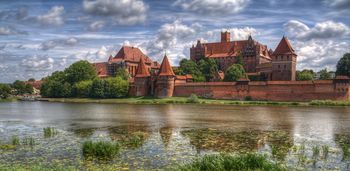Malbork Castle: Difference between revisions
imported>Richard Nevell No edit summary |
imported>Richard Nevell (Add a source) |
||
| Line 6: | Line 6: | ||
'''Malbork Castle''' in [[Poland]] was founded in the 13th century by the [[Order of Teutonic Knights]].<ref>Emery, Anthony (2007). [http://www.castlestudiesgroup.org.uk/Malbork%20-%20Anthony%20Emery.pdf "Malbork Castle – Poland"], ''The Castle Studies Group Journal'' 21. p. 139.</ref> | '''Malbork Castle''' in [[Poland]] was founded in the 13th century by the [[Order of Teutonic Knights]].<ref>Emery, Anthony (2007). [http://www.castlestudiesgroup.org.uk/Malbork%20-%20Anthony%20Emery.pdf "Malbork Castle – Poland"], ''The Castle Studies Group Journal'' 21. p. 139.</ref> | ||
The Order of the Teutonic Knights was | The Order of the Teutonic Knights was by German knights who accompanied [[Frederick Barbarossa]] on the [[Third Crusade]]. The army disbanded after Barbarossa drowned. The Order was given papal recognition by [[Innocent III]] in 1199.<ref>Sterns, Indrikis (1985). "The Teutonic Knights in the Crusader States" in Kenneth Meyer Setton, Norman P. Zacour, and Harry W. Hazard (eds.), ''A History of the Crusades, Volume V: The Impact of the Crusades on the Near East''. pp.–317. University of Wisconsin Press. ISBN 0-299-09140-6.</ref> Though founded to protect Christians in the Near East, the Order turned its attention to eastern Europe and in 1226 attacked the pagan Prussians of eastern Europe near the Baltic Sea. The intention was to convert the Prussians to Christianity and protect the lands of the Christian Polish princes. In 1283 the Kingdom of the Teutonic Knights was inaugurated.<ref>Emery, "Malbork Castle – Poland", pp. 141–142.</ref> Construction of Malbork Castle began in 1272. | ||
Malbork Castle is mainly built from red brick. This was the case for many castles along the coast of the [[Baltic Sea]] as the region was poor in stone suitable for construction.<ref>Emery, "Malbork Castle – Poland", p. 143.</ref> The castle is divided into three enclosures: the Outer Castle, the Middle Castle, and the Upper Castle.<ref>Emery, "Malbork Castle – Poland", p. 140.</ref> In 1997 Malbork Castle was designated a World Heritage Site by UNESCO, recognising the importance of the site. It is named the "Castle of the Teutonic Order in Malbork".<ref>[http://whc.unesco.org/en/list/847 Castle of the Teutonic Order in Malbork], UNESCO, accessed 28 February 2013.</ref> | Malbork Castle is mainly built from red brick. This was the case for many castles along the coast of the [[Baltic Sea]] as the region was poor in stone suitable for construction.<ref>Emery, "Malbork Castle – Poland", p. 143.</ref> The castle is divided into three enclosures: the Outer Castle, the Middle Castle, and the Upper Castle.<ref>Emery, "Malbork Castle – Poland", p. 140.</ref> In 1997 Malbork Castle was designated a World Heritage Site by UNESCO, recognising the importance of the site. It is named the "Castle of the Teutonic Order in Malbork".<ref>[http://whc.unesco.org/en/list/847 Castle of the Teutonic Order in Malbork], UNESCO, accessed 28 February 2013.</ref> | ||
Revision as of 13:35, 28 February 2013

Malbork Castle was built from brick because suitable building stone was not available nearby.
Malbork Castle in Poland was founded in the 13th century by the Order of Teutonic Knights.[1]
The Order of the Teutonic Knights was by German knights who accompanied Frederick Barbarossa on the Third Crusade. The army disbanded after Barbarossa drowned. The Order was given papal recognition by Innocent III in 1199.[2] Though founded to protect Christians in the Near East, the Order turned its attention to eastern Europe and in 1226 attacked the pagan Prussians of eastern Europe near the Baltic Sea. The intention was to convert the Prussians to Christianity and protect the lands of the Christian Polish princes. In 1283 the Kingdom of the Teutonic Knights was inaugurated.[3] Construction of Malbork Castle began in 1272.
Malbork Castle is mainly built from red brick. This was the case for many castles along the coast of the Baltic Sea as the region was poor in stone suitable for construction.[4] The castle is divided into three enclosures: the Outer Castle, the Middle Castle, and the Upper Castle.[5] In 1997 Malbork Castle was designated a World Heritage Site by UNESCO, recognising the importance of the site. It is named the "Castle of the Teutonic Order in Malbork".[6]
References
- ↑ Emery, Anthony (2007). "Malbork Castle – Poland", The Castle Studies Group Journal 21. p. 139.
- ↑ Sterns, Indrikis (1985). "The Teutonic Knights in the Crusader States" in Kenneth Meyer Setton, Norman P. Zacour, and Harry W. Hazard (eds.), A History of the Crusades, Volume V: The Impact of the Crusades on the Near East. pp.–317. University of Wisconsin Press. ISBN 0-299-09140-6.
- ↑ Emery, "Malbork Castle – Poland", pp. 141–142.
- ↑ Emery, "Malbork Castle – Poland", p. 143.
- ↑ Emery, "Malbork Castle – Poland", p. 140.
- ↑ Castle of the Teutonic Order in Malbork, UNESCO, accessed 28 February 2013.